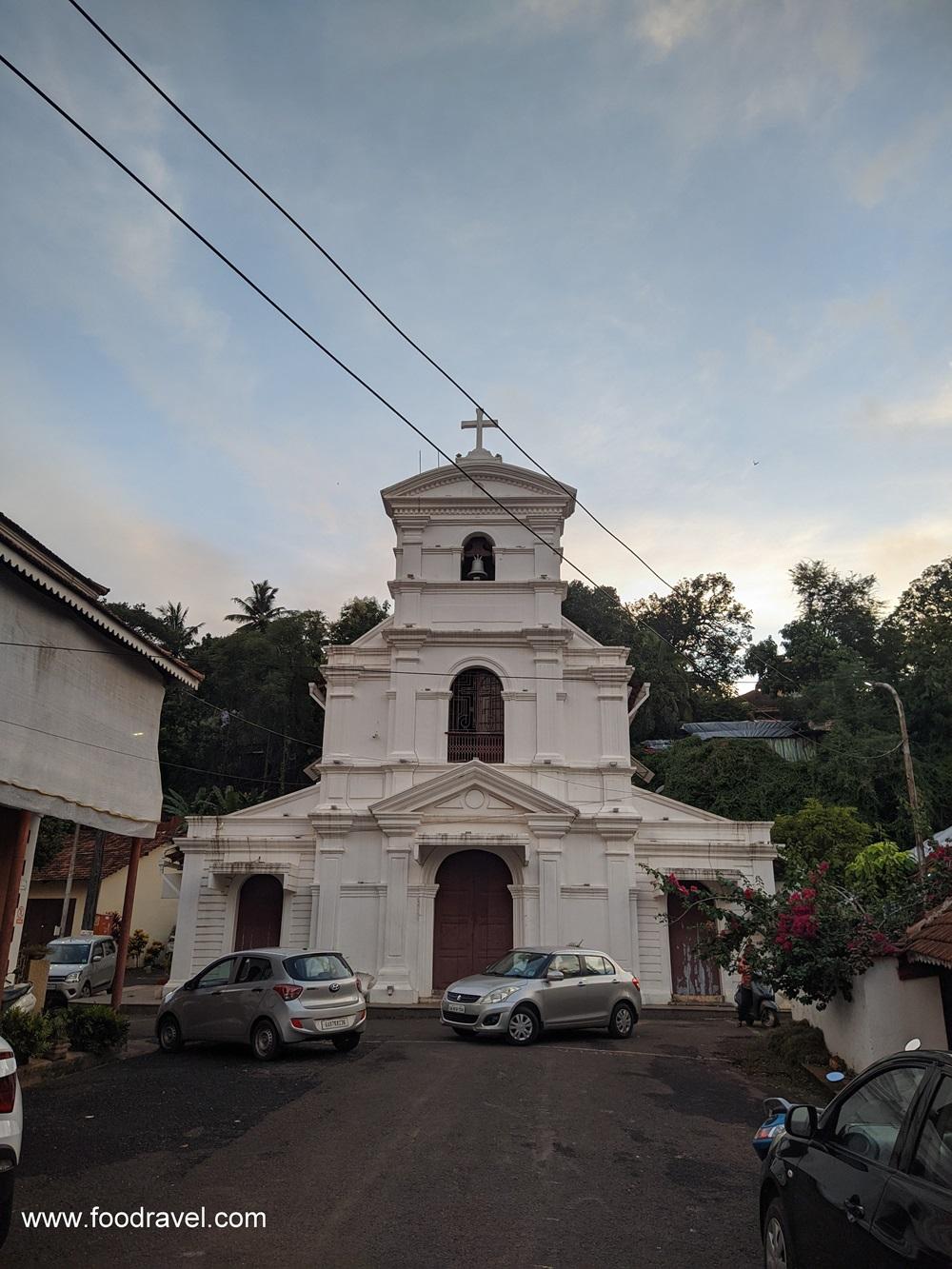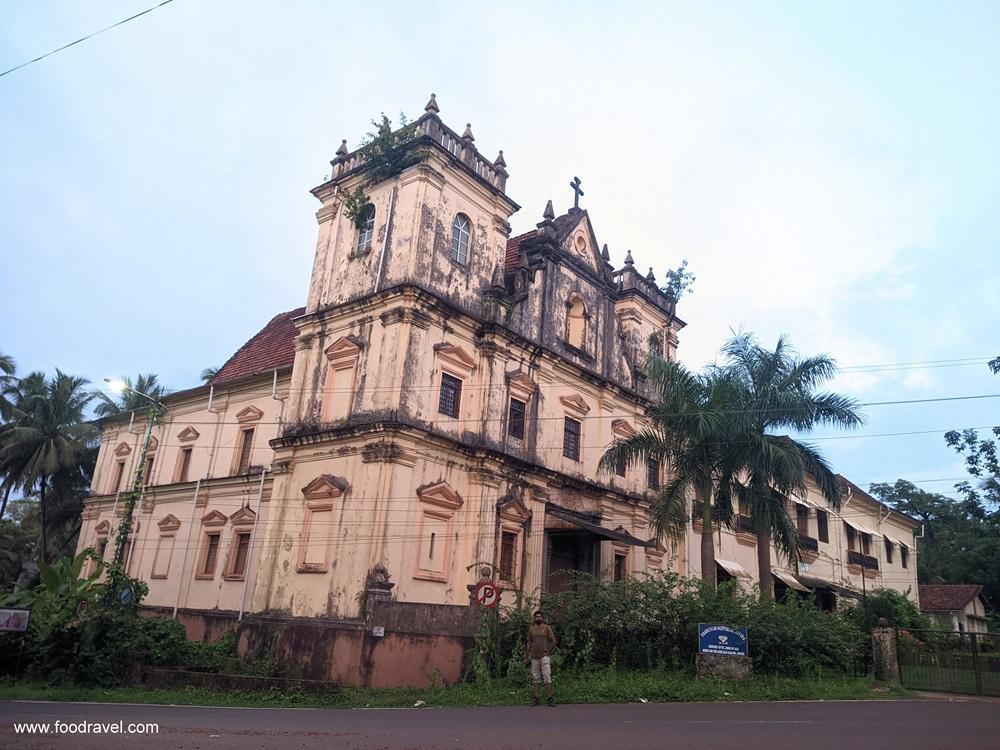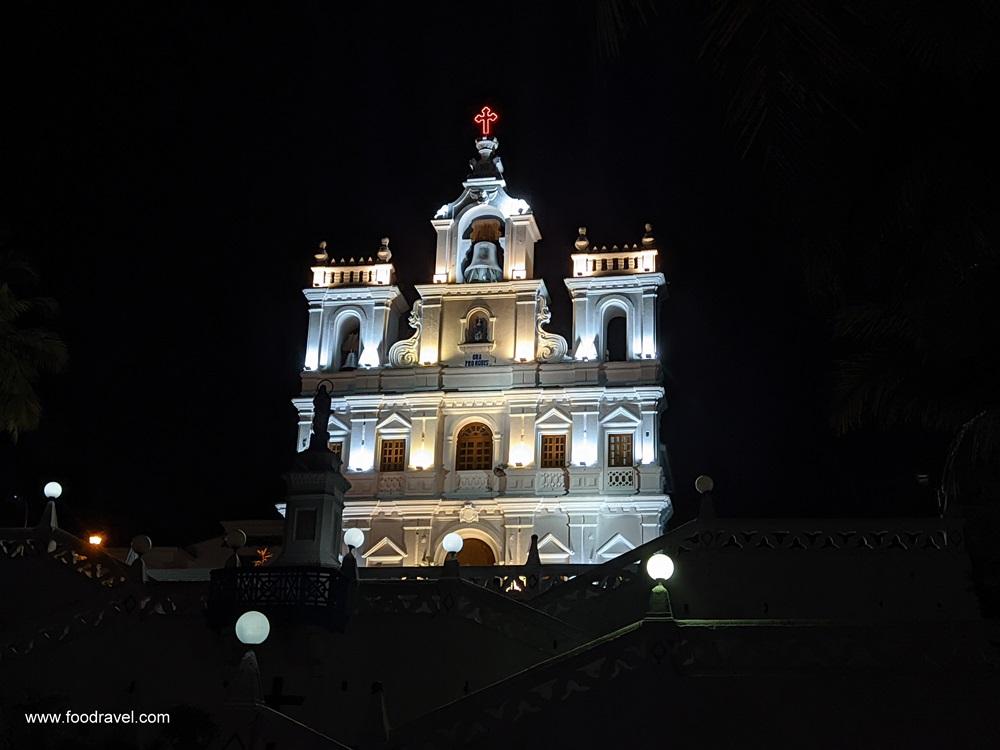Goa, renowned for its coastal allure and pristine beaches, is not merely a tropical paradise but also a custodian of a rich cultural heritage, notably represented by its historic churches. During my week-long stay in this charming state, I was fortunate to explore some of its most iconic religious landmarks. The churches to visit in Goa stand as architectural and historical gems, testaments to the region’s colonial past. One such notable site is the Basilica of Bom Jesus, a UNESCO World Heritage Site, known for housing the mortal remains of St. Francis Xavier. The baroque architecture and intricate detailing in this church offer a glimpse into the region’s Portuguese influence.
Another captivating church to visit in Goa is the Se Cathedral, dedicated to St. Catherine of Alexandria. This colossal structure is an embodiment of Portuguese Manueline style and houses the Golden Bell, one of the largest in Asia. The sheer grandeur of the Se Cathedral reflects the spiritual and cultural significance embedded in Goa’s history. The Church of St. Cajetan, resembling the St. Peter’s Basilica in Rome, is another architectural marvel. Constructed with Corinthian influences, this church showcases the seamless blend of European aesthetics with local craftsmanship.
In addition to these churches of Goa, the Church of St. Augustine, with its iconic ruins, adds a touch of mystique to the cultural spectrum of Goa. The dilapidated yet enchanting structure stands as a reminder of the past glory of the Augustinian friars in the region. Exploring these churches in Goa not only offered a glimpse into Goa’s religious history but also provided a serene escape from the bustling beach scenes. The spiritual ambiance and historical significance of these churches added a profound layer to my overall experience in Goa, making it a truly enriching journey.
Venturing beyond the sandy shores of Goa, my exploration delved into the rich spiritual and cultural fabric that defines this coastal haven. Amidst the lush landscapes and vibrant scenes, I uncovered significant landmarks, each a silent storyteller of Goa’s profound history. Time seemed to stand still in the presence of ageless repositories, where the past and present coexisted in harmony. Grandeur adorned these cultural gems, their architectural marvels echoing tales of a bygone era. As I meandered through this historical narrative, the blend of captivating stories and scenic beauty added layers of depth to my Goa experience, creating enduring memories of a place where time seems to dance between tradition and modernity.
Here’s a list of churches to visit in Goa during your journey.
Discovering Churches to Visit in Goa: Basilica of Bom Jesus - A Testament to Timeless Faith and Architectural Grandeur

The Basilica of Bom Jesus in the heart of Goa is a testament to architectural brilliance and spiritual significance. Constructed between 1594 and 1605, this UNESCO World Heritage Site exemplifies baroque architecture with laterite and lime adorning its exterior, reflecting Goa’s historical evolution during the Portuguese colonial era. Approaching the basilica, simplicity veils intricate details within, reflecting architectural styles of a bygone era. The basilica, focusing on austerity and elegance, transports visitors to a time when Goa thrived as a hub of cultural and religious exchange. Among the most famous churches to visit in Goa, Bom Jesus Basilica is known for its past and cultural heritage.
Distinguished as the final resting place of St. Francis Xavier, the Jesuit church serves as a mausoleum. The saint’s remains, brought from Malacca in 1553, rest in an ornate silver casket, blending religious devotion with architectural grandeur. Entering the hallowed halls, a profound sense of reverence permeates. The interior unfolds as a marble sanctuary, adorned with gilded altars gleaming softly in dim light. Exquisite frescoes depict scenes from the life of St. Francis Xavier, each brushstroke narrating a tale and deepening the spiritual experience.
The Basilica of Bom Jesus houses a valuable art gallery, a treasure trove of Christian art spanning eras. From delicate sculptures to vivid paintings, the gallery offers a visual journey through artistic evolution within religious devotion, contributing to the basilica’s cultural richness and historical legacy. Beyond architecture, the basilica stands as a living chronicle of Goa’s spiritual journey, a silent witness to history. With every step, visitors are transported into a sacred space where echoes of devotion and cultural richness create an immersive experience transcending time. If you are thinking about which churches to visit in Goa, you should include this in your list.
St. Francis of Assisi Church and Convent: A Timeless Testament to Goa’s Rich Cultural Past

The St. Francis of Assisi Church and Convent, situated in the heart of Goa, is a poignant representation of the region’s rich history and cultural heritage. Constructed in the 17th century, this iconic structure stands as a testament to the enduring legacy of the Portuguese influence in Goa. The church, dedicated to St. Francis of Assisi, a revered Catholic saint, showcases a harmonious blend of architectural styles, including the Manueline and Tuscan influences. The exterior is characterized by simplicity, while the interior unfolds a treasure trove of religious art, with intricately carved woodwork and ornate altars.
Adjacent to the church, the St. Francis of Assisi Convent complements the religious ambiance. The convent, with its serene courtyards and austere architecture, provides a glimpse into the tranquil life led by the Franciscan friars who once resided there.
One of the notable features of the church is the Chapel of St. Catherine, which houses the relics of St. Catherine. Pilgrims and visitors are drawn to this sacred space, where a sense of reverence and spirituality permeates the air. The St. Francis of Assisi Church and Convent have witnessed centuries of change, yet they remain steadfast, offering a connection to Goa’s historical roots. The site stands not only as a place of worship but also as a living monument, inviting all to explore its corridors, appreciate its architectural grandeur, and reflect on the cultural spectrum woven into the fabric of Goa’s identity. This church should be in your list of churches to visit in Goa.
Our Lady of Piety Church: A Tranquil Haven on Divar Island Weaving Centuries of Spiritual Legacy - Churches to Visit in Goa

In the serene village of Piedade on Divar Island, the Our Lady of Piety Church, also known as the Church of Our Lady of Compassion, stands as a testament to centuries of spiritual heritage. Initially a chapel in 1541, it underwent transformative journeys, being rebuilt in 1625 and later converted into the Our Lady of Piety Church, completed in 1724. Honoring Nossa Senhora de Piedade (Our Lady of Piety), the church celebrates a vibrant feast on the 2nd Sunday of May. Designed by a Goan priest, the church offers panoramic views from its hilltop location, holding historical significance as it was constructed on the site of an ancient Hindu temple destroyed in the late 15th century.
Remnants of the Kadamba era grace the south side, with a small walled cemetery revealing a chapel believed to be converted from a former Hindu shrine. Originating from a chapel constructed in December 1515, dedicated to Nossa Senhora de Divar, it served the villages of Goltim and Navelim. Historical accounts, such as Gaspar Correia’s, recount that Alfonso de Albuquerque, driven by a desire to see the Church dedicated to Our Lady of Piety in Divar, passed away on December 27, 1515, upon witnessing the church.
Attributed to Rui de Silveira in 1541, the chapel expanded and was elevated to the status of a church by Archbishop D. Frei Sebatiao De S. Pedro in 1625. The present church, completed in 1724, owes its architectural grandeur to Fr (Msgr) Antonio Joao de Frias, the Vicar of Piedade. In the time-honored tradition of Goan churches, the Our Lady of Piety Church unfolds a captivating tale from its history pages. A captain, facing a perilous ship, vowed to donate the bell upon survival. Fate led him to Divar Island, fulfilling his vow to the Church of Divar. An exchange with the Se Cathedral preserved the church’s sanctity. This intriguing episode adds a unique layer to the spiritual narrative of Our Lady of Piety Church on Divar Island. Among the not to miss churches to visit in Goa, this church will surely make your list complete.
St. Augustine Tower: Echoes of Time in the Ruins of Old Goa’s Spiritual Legacy

Nestled in Old Goa’s captivating labyrinth and among the most famous churches to visit in Goa, the ruins of St. Augustine Tower, a UNESCO World Heritage Site, echo with tales of the past. A testament to the Augustinian friars’ 16th-century endeavor, it stood alongside a grand church, embodying faith and architectural brilliance. The tower, now an imposing silhouette, invites exploration of Old Goa’s mysteries. Founded between 1597 and 1602 atop Monte Santo, St. Augustine Tower was one of three distinguished Augustinian churches globally. An intriguing historical connection lies in its bell, now at Our Lady of the Immaculate Conception Church, emphasizing the intertwined fates of these landmarks.
Beyond history, the tower found cinematic fame in the 1965 thriller “Gumnaam,” leaving an indelible mark in popular culture. Perched on Holy Hill, it has weathered centuries, bearing witness to Goa’s dynamic history since the arrival of Augustinian friars in 1587. Once celebrated alongside renowned counterparts, El Escorial and the Monastery of São Vicente de Fora, fate dealt a different hand in 1835. Portuguese policies led to abandonment, and by 1871, the bell found a new home. The church’s gradual decay culminated in 1931, leaving only half the tower standing, a poignant testament to the resilience of history amidst the shifting tides of time.
St. Sebastian Chapel: A Timeless Sanctuary of Faith and History in Fontainhas, Goa

Nestled in Salcette, Goa, the St. Sebastian Chapel, built-in 1818, stands as a cherished tourist attraction steeped in history. Dedicated to St. Sebastian, renowned for healing and miracles, the chapel played a pivotal role during outbreaks of pestilence, offering divine intervention and relief to the distressed locals. Reflecting Goa’s colonial legacy, the chapel’s architecture exudes charm with a small nave and a narrow corridor leading to the choir. Its centerpiece, a unique crucifix from the Inquisition era, captivates with Christ portrayed with open eyes, believed to hold magical properties. The crucifix’s journey from the Palace of Inquisition to the chapel adds layers to its historical significance.
Inside, the chapel boasts a statue of the Virgin Mary and artifacts from a church in Diu, showcasing cultural connections beyond Goa’s borders. An annual street feast in mid-November honors the Feast of Our Lady of Livrament, with the chapel as the focal point. An intricately attached well enhances its historical significance, contributing to Goa’s rich heritage. Hidden in Fontainhas, the heart of Goa, the St. Sebastian Chapel is not just an architectural gem but a testament to history, faith, and cultural exchange. The interior’s blend of simplicity and elegance, the enigmatic crucifix, and treasures from afar make it a captivating window into Goa’s past.
St. John of God Convent's Journey Through Time in North Goa - Famous Churches to Visit in Goa

Nestled in the serene landscapes of North Goa, the St. John of God Convent is a hidden gem with a profound place in the region’s history. Erected in 1685 during the Portuguese era, this enchanting edifice dedicated to Our Lady of Good Success stands adjacent to the iconic St. Augustine Tower, showcasing traditional Portuguese architectural designs.
Originally established by eight Brothers from the Congregation of St. John of God, their mission was to create a sanctuary for the ailing under the patronage of King Dom Pedro II. Over time, the convent transformed into a hospital in 1835, catering to the indigent, and later found new purpose under the nuns of St. Monica. In 1961, the Portuguese Military Force restored the timeworn structure, passing stewardship to the Sisters of the Congregation of the Portuguese Franciscan Hospitallers in 1964. Today, they operate an Old Age Home, preserving the legacy of care and compassion that began in 1685.
Architecturally, the convent combines Baroque and Portuguese styles, with intricate details and carvings gracing its facade. The chapel, a true gem, features awe-inspiring frescoes, stained glass windows, and ornate altars that reflect the craftsmanship of yesteryears. Renovations over the years have preserved its grandeur, showcasing a commitment to maintaining Goa’s architectural heritage. Beyond its religious role, St. John of God Convent has been a cultural hub, hosting weddings, festivals, and communal gatherings. It stands as an embodiment of Goa’s historical and cultural richness, providing a glimpse into the region’s past and present within its timeless walls.
Our Lady of the Immaculate Conception Church, Panjim’s Crown of Faith and History

Perched on a picturesque hillside, the Our Lady of the Immaculate Conception Church, with roots dating back to 1541, offers panoramic views of Panjim. Evolving from a modest chapel to a grand Baroque masterpiece in the 1600s, the church embodies Goa’s rich history and Portuguese influence. In 1600, it attained Parish status, marking its significance in the community. The 18th-century addition of symmetrical zigzag stairways and the 1871 inclusion of the second-largest church bell in Goa enhanced its architectural grandeur. The exterior, a splendid example of Portuguese Baroque, features a majestic belfry dominating the facade, earning the church the title of Panjim’s ‘crown.’ The orthodox cruciform design of the interior, with vibrant decor and intricate altars dedicated to Mother Mary, Jesus’s Crucifixion, and Our Lady of the Rosary, showcases artistic richness. Special occasions see the vaulted ceiling adorned with delicate blue and white floral arrangements.
The church’s architectural masterpiece reflects Portuguese Baroque grandeur, characterized by ornate detailing and a central belfry. The grand staircase and iconic facade invite visitors into a divine space that seamlessly intertwines history, culture, and faith. The Our Lady of the Immaculate Conception Church stands not only as a place of worship but as a captivating art gallery where the divine and the artistic converge, contributing to its identity as a significant cultural and historical landmark in Goa.

Embarking on a week-long journey through the heart of Goa, I had the privilege of exploring seven churches to visit in Goa that whispered tales of centuries gone by. Each sacred haven unfolded a unique chapter in Goa’s illustrious history, leaving an indelible mark on my soul. As I reflect on this enriching pilgrimage, a profound realization dawns upon me – there are more churches in Goa awaiting discovery.
Among the cherished seven, the Basilica of Bom Jesus stood timeless, cradling the relics of St. Francis Xavier, while the Se Cathedral echoed with the grandeur of Portuguese influence. The Church of St. Cajetan and the evocative ruins of the Church of St. Augustine whispered tales of bygone eras, their architectural splendor painting a rainbow of cultural heritage. However, my spiritual sojourn left me yearning for more. Goa, with its myriad churches, holds secrets and stories yet untold. The allure of the Chapel of St. Catherine, the tranquility of the Church of St. Ana, and the historical resonance of the Church of Our Lady of the Rosary beckon me for a future exploration
The Chapel of St. Catherine, a hidden gem nestled in Old Goa, is a testament to simplicity and serenity. Its unassuming facade belies the inner beauty that awaits, offering a peaceful retreat for contemplation. The Church of St. Ana, known for its remarkable architecture, invites pilgrims into a space where time seems to stand still. The intricate carvings and historical significance make it a must-visit for anyone seeking a deeper connection with Goa’s past.
The Church of Our Lady of the Rosary, a beacon of faith overlooking the Mandovi River, is steeped in history. As I missed its presence during my initial visit, its iconic facade and the stories engraved in its walls have become an essential destination for my next pilgrimage. Though my first journey to Goa unfolded the tales of seven extraordinary churches, the prospect of revisiting to explore the hidden treasures of St. Catherine, St. Ana, and Our Lady of the Rosary stirs anticipation. Goa, with its rich ecclesiastical heritage, promises a spiritual odyssey that transcends time, and I eagerly await the day when I can unravel the stories woven into the hallowed walls of these undiscovered gems.
![]()

